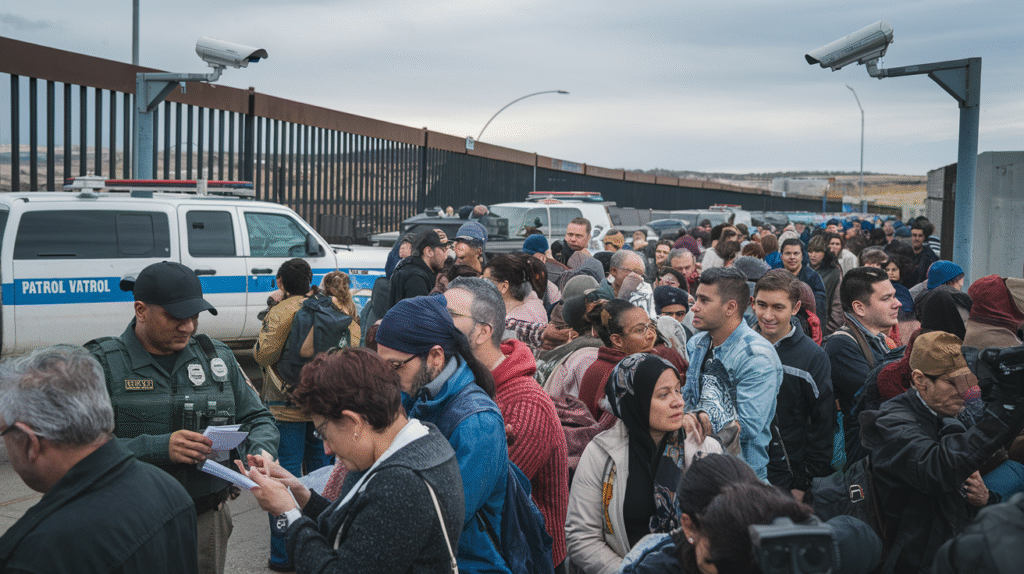Top 5 Global Updates
In a world that never stops spinning, significant events continue to reshape our geopolitical landscape. From a potential breakthrough in the Middle East conflict to concerning population trends in global superpowers, the past week has delivered pivotal moments that demand our attention. Are you keeping up with these rapid changes that could impact our collective future?
As Israeli Prime Minister Netanyahu announces a ceasefire deal with Hamas, Germany intercepts suspicious drones near military sites, and South Korea’s impeached president faces arrest after a tense standoff with investigators. Meanwhile, the United States prepares for potential major shifts in border enforcement, and China grapples with its third consecutive year of population decline. These developments aren’t just headlines—they’re signals of profound transitions happening across continents.
Join us as we dive into the five most critical global updates you need to understand this week, exploring the ceasefire negotiations in Gaza, worldwide political upheavals, migration challenges, population concerns, and other noteworthy international events that are defining our moment in history.
Middle East Developments: Israel-Hamas Ceasefire Deal

Netanyahu’s announcement and last-minute obstacles
Israel and Hamas are engaged in serious negotiations to establish a cease-fire in Gaza after a prolonged period of stalled discussions. A leaked truce proposal reveals potential concessions from both parties. However, Israeli Prime Minister Benjamin Netanyahu has dismissed the current proposal as inadequate, insisting that Hamas should not be allowed to regain its military capabilities. Internal pressures from Netanyahu’s coalition further complicate the potential for concessions.
The Israeli Defense Forces (IDF) have launched a significant military operation called “Gideon’s Chariots,” aimed at capturing strategic locations within Gaza. This offensive follows warnings to Hamas that military action would commence if negotiations faltered. Israeli officials, including Katz, contend that recent military operations in Gaza have compelled Hamas to engage in dialogue.
Hostage release arrangements
The initial phase of the proposed peace plan entails a 42-day cessation of hostilities, during which Hamas would release 33 hostages, prioritizing Israeli women, minors, and the elderly. The release would occur incrementally, with three hostages freed every week. In exchange, Israel would release Palestinian prisoners, with specific ratios depending on the type of hostages released.
Subsequent phases of the plan involve the potential release of remaining hostages and a broader prisoner exchange, contingent upon the establishment of lasting peace. The final stage would address the remains of deceased hostages and further prisoner releases.
Ongoing broader conflict concerns
The proposal faces considerable challenges beyond the immediate hostage situation. Israeli troops would withdraw from Gaza in a phased manner, starting on the third day of the cease-fire. This would include reducing military presence and halting aerial operations for designated hours. Humanitarian efforts would also increase, permitting significant aid deliveries to Gaza, including essentials and infrastructure repairs.
Negotiations for a “sustainable calm” are set to commence by the 16th day of the cease-fire, aiming for a permanent cessation of hostilities and complete Israeli withdrawal from Gaza. The U.S. has expressed a desire to prevent the reoccupation of Gaza, advocating for a political framework that reinstates the Palestinian Authority, which has been historically opposed by Netanyahu’s government.
Meanwhile, Palestinian Authority President Mahmoud Abbas has urged Hamas to relinquish its control over Gaza and disarm, framing the ongoing violence as a threat to Palestinian statehood. Despite Hamas indicating a willingness to agree to a temporary ceasefire, it remains resistant to permanent disarmament.
With the Israel-Hamas conflict continuing to evolve amidst complex regional dynamics, next we’ll examine how these Middle East developments fit into the broader context of Political Shifts and Legal Actions Worldwide, where similar patterns of negotiation and confrontation are shaping international relations.
Political Shifts and Legal Actions Worldwide

Moving from the complex negotiations in the Middle East ceasefire talks, we now turn our attention to significant political developments occurring across different regions of the world, where democratic principles and legal systems face mounting challenges.
Russian Imprisonment of Navalny’s Lawyers
In a troubling display of how authoritarian regimes utilize legal systems to suppress dissent, Russia has recently imprisoned lawyers representing opposition figures. This aligns with research showing that in authoritarian regimes (Democracy Index 0-4), higher development paradoxically correlates with increased incarceration rates. Unlike full democracies where judicial oversight protects citizens, Russian authorities demonstrate how undemocratic systems use imprisonment as a political tool, targeting not only activists but also their legal representatives, effectively undermining the right to defense.
South Korea’s Impeached President Arrest
South Korea’s case represents the complexities of legal accountability in flawed democracies. The arrest of an impeached president highlights how political transitions can lead to legal consequences for former leaders. This situation reflects the global pattern where nations with higher development indices but imperfect democratic systems still struggle with using incarceration as a political mechanism. The Gini coefficient research suggests that economic inequality—a factor in South Korea’s political tensions—correlates with increased incarceration rates in such democracies.
Georgia’s Opposition Leader Attack
The recent attack on Georgia’s opposition leader exemplifies the disturbing global trend of declining democracy. As the reference material notes, autocracies now encompass 70% of the global population despite a 22% growth in human development since 1990. Georgia, classified as a hybrid regime (Democracy Index 4-6), demonstrates how political violence can flourish in systems with weakened democratic institutions, creating environments where opposition figures face physical danger rather than just legal persecution.
These global political shifts highlight a concerning worldwide pattern where judicial systems are increasingly weaponized against political opponents. With these governance challenges in mind, we’ll next examine how these political instabilities contribute to “Migration and Border Control Challenges,” as citizens flee deteriorating political conditions in search of safer environments.
Migration and Border Control Challenges

Now that we have examined the political shifts and legal actions taking place worldwide, let’s turn our attention to the growing challenges in migration and border control that are reshaping national policies across the globe.
U.S. Border Enforcement Under Trump Preparations
The current U.S. administration is implementing substantial changes to immigration enforcement mechanisms. These reforms include expedited processing for asylum seekers with significantly stricter eligibility criteria. Individuals seeking asylum now face tougher regulations requiring comprehensive proof of credible fear to qualify for protection. The credible fear interview process has become more rigorous, demanding thorough evidence collection and proper legal guidance to enhance the chances of success. Deportation priorities have been redefined, with increased focus on individuals with criminal records while simultaneously expanding enforcement operations in various areas.
Potential Termination of Migrant Entry App
Among the most controversial proposed changes is the possible termination of digital systems that currently facilitate migrant processing. This shift would significantly impact asylum seekers who rely on these platforms to initiate their claims. The administration has indicated plans to implement heightened scrutiny for visa applications, especially affecting work-based visas such as the E2 investor visa. These changes, coupled with existing backlogs, create substantial processing challenges for both family-based and employment-based immigration pathways. The situation has created confusion among migrants regarding their detention and deportation processes, leading to multiple legal challenges in the courts.
Sweden’s Controversial Citizenship Removal Proposal
In parallel with U.S. developments, Sweden is pursuing controversial citizenship policies that would allow for the removal of citizenship under certain circumstances. This mirrors a contentious proposal in the U.S. regarding birthright citizenship, where the administration seeks to deny citizenship to children born in the United States to parents without legal status. Legal analysts widely view this move as potentially unconstitutional, resulting in multiple lawsuits challenging the administration’s directive. The Supreme Court is scheduled to hear cases regarding this order along with other immigration-related policies, including restrictions on asylum access.
As these migration and border control challenges continue to evolve, they inevitably intersect with broader global population trends and security concerns, which we will explore in the next section.
Global Population and Security Concerns

Now that we have covered the challenges related to migration and border control, let’s examine some significant global population trends and security issues that have garnered international attention.
China’s Declining Population for Third Consecutive Year
China’s population has declined for the third consecutive year, presenting a major demographic challenge for the world’s most populous nation. In 2024, the population decreased to 1.408 billion, marking a decline of 1.39 million from the previous year. More concerning is that this population decrease follows seven consecutive years of declining birth rates, despite the government’s efforts to reverse the trend.
The Chinese Communist Party under Xi Jinping has implemented various policy measures, including:
- Relaxation of the one-child policy in 2016
- Further adjustments allowing three children in 2021
- Introduction of new pro-natal policies
Despite these efforts, the demographic shift continues, with the proportion of individuals aged 65 and older rising to 15.6%. While there was a slight uptick in births in 2024 to 9.54 million—partly attributed to the auspicious Year of the Dragon—this was overshadowed by a higher mortality rate of 7.76 per 1,000.
Experts from the National Bureau of Statistics point to the decreasing number of women of childbearing age as a long-term challenge. Additionally, economist Yi Fuxian warns that falling marriage rates could lead to even lower birth rates in coming years.
This population decline poses significant threats to China’s economy, especially given the concurrent economic slowdown and an aging workforce. Young Chinese increasingly prioritize personal and professional aspirations over starting families, despite continued governmental efforts to promote family growth.
Germany’s Drone Interception Near Military Sites
With rising global security concerns affecting nations worldwide, we’re seeing increased vigilance around critical infrastructure and military installations. The case of Germany’s drone interceptions highlights the growing security challenges nations face in protecting sensitive locations in an era of advanced technology.
With this mind, next we’ll examine notable international events and transitions that are reshaping global dynamics in unexpected ways.
Notable International Events and Transitions

Now that we have examined global population trends and security concerns, it’s important to turn our attention to significant events unfolding in specific countries that impact international diplomatic relations.
Vanuatu’s Snap Election Following Earthquake
The Global News website has been covering developments in Vanuatu, where a snap election has been called in the aftermath of a devastating earthquake. This Pacific island nation is facing political uncertainty during a time of natural disaster recovery, adding complexity to the region’s stability. The earthquake has not only disrupted the physical infrastructure but has also necessitated immediate political action to address the resulting humanitarian needs.
Canada’s Preparation for Potential U.S. Tariffs
In economic news, Canada is actively developing contingency plans in anticipation of potential new tariffs from the United States. This preparation highlights the ongoing tensions in international trade relations and their potential impact on the Canadian economy. The Global News platform has been providing comprehensive coverage of this situation across multiple Canadian regions including Toronto, Calgary, Edmonton, Halifax, Winnipeg, and Barrie.
These developments underscore the interconnected nature of global events and their effects on diplomatic relations worldwide. Canadian officials are engaging with their U.S. counterparts while simultaneously preparing domestic industries for possible economic adjustments. The situation demonstrates how international trade policies can significantly influence bilateral relationships between neighboring countries.
Both these events represent important transitions in the global landscape, with potential long-term implications for international cooperation and diplomatic engagement. The Global News website continues to offer updates on these stories, allowing readers to stay informed about these crucial developments through their various regional platforms and breaking news alerts.
Conclusion
As we’ve explored these top global updates, the complexity of our interconnected world becomes evident. From the tenuous Israel-Hamas ceasefire agreement to Russia’s political repressions and China’s concerning population decline, these developments highlight significant humanitarian, political, and demographic challenges. The shifting landscape of migration policies, border controls, and citizenship reforms across the US, Europe, and beyond reflects growing tensions around national security and human rights.
These global events remind us that despite geographic distances, the ripple effects of political decisions, conflicts, and social changes affect us all. Whether it’s the devastating physical toll visible in Gaza’s satellite imagery or the warnings in President Biden’s farewell address about wealth concentration and disinformation, staying informed about these developments is crucial. As citizens of a global community, our awareness and engagement with these issues can help shape more just and peaceful outcomes in an increasingly complex world.





